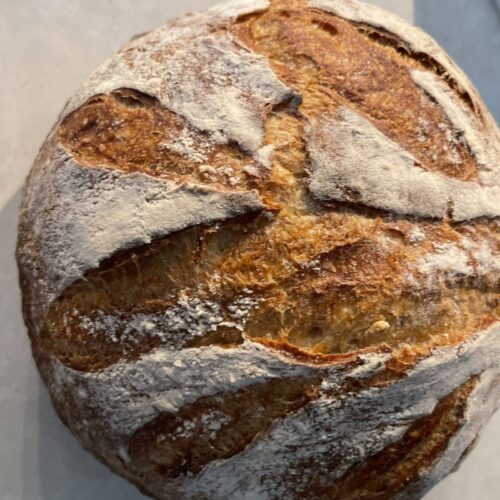Sourdough Bread: Fresh and Delicious
Easy-to-follow sourdough bread recipe. Using just a few simple ingredients – flour, water, salt, and a lively sourdough starter – you can create a delicious, artisan loaf with a crispy crust and a soft, chewy crumb. Perfect for beginners and seasoned bakers alike.

Ingredients
Instructions
Making Your Sourdough Bread Dough
-
Ensure your sourdough starter is active and bubbly. You should feed it about 4-6 hours before you plan to mix your dough. I recommend using the float test to check your sourdough starter. Simply fill a glass with water and drop a teaspoon of sourdough starter in the water. If the starter floats, it is ready to use.
-
In a large mixing bowl, combine the water and starter and mix well, add the flour and salt. Mix until no flour is visible and a shaggy dough has formed. After mixing, let the dough rest for 1 hour.
-
With wet hands, gently lift one side of the dough, stretch it upwards, and fold it over to the opposite side. Rotate the bowl a quarter turn and repeat the process. Do this four times. Cover the bowl and let it rest for another 30 minutes.
-
Perform the stretch and fold method every 30 minutes for the next 2 hours. This will be a total of 4 sets of stretch and folds. During this time, you'll notice the dough becoming smoother and more elastic.
-
After the final stretch and fold, cover the bowl and let the dough rise at room temperature until it has doubled in size. This can take anywhere from 6 to 10 hours, depending on the temperature of your kitchen and the strength of your starter.
-
Once the dough has doubled in size, gently turn it out onto a lightly floured surface. Shape it into a round or oval loaf by folding the edges into the center, then flip it over and gently shape it with your hands. Place the shaped dough into a proofing basket or a bowl, seam side up. Cover with a cloth or plastic wrap.
-
Let the dough proof at room temperature for 1-2 hours, or refrigerate it for 12-24 hours for a slower fermentation and deeper flavor. If refrigerating, bake the dough straight from the fridge.
-
Place a Dutch oven (or heavy pot with a lid) in your oven and preheat to 475°F (245°C) for at least 30 minutes.
-
Carefully remove the preheated Dutch oven from the oven. Turn the dough out onto a piece of parchment paper or bread sling, seam side down. Using a sharp knife or razor blade, score the top of the dough with a few slashes.
-
Transfer the dough (with the parchment paper or bread sling) into the Dutch oven. Cover with the lid and place it in the oven. Bake for 20 minutes with the lid on. After 20 minutes check your bread, and continue baking with the cover on until the bread is 190℉ (88℃). I recommend to check my bread every 10 minutes after the first initial 20 minutes.
-
Once you have reached the internal temperature of 190℉ (88℃), remove the lid and bake for an additional 10-15 minutes, or until the crust is deeply golden and the bread sounds hollow when tapped on the bottom.
-
Carefully remove the bread from the Dutch oven and let it cool on a wire rack for at least an hour before slicing. This helps set the crust and crumb.
Sourdough, Bread, Sourdough Starter, Artisan Bread, Bread Baking, Easy Sourdough Recipe, Natural Yeast


